
Mr Monald Moss of Margate, Brisbane recently contacted State Library to pass on the story of his father-in-law George Frederick Saban, who fought in both the Boer War and the First World War. In posting George’s story, we are pleased to share the story of an Australian who served, and fulfil Mr Moss’ wish to publish some permanent recollections for his family.
Most of the information Mr Moss passed on came from George Frederick’s children - son Tom Saban, daughter Cynthia Squires, and daughter Olive (Mr Moss' wife), who remembered what her father had told her as she helped him on his Saturday fruit and veggies run.
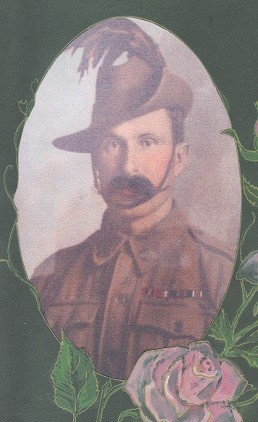
George Frederick Saban was born on 30th January 1881 in County Carmarthen, South Wales. He was seven years old when his mother passed away. Although his father remarried, George could not get along with his step-mother, who had children of her own, so George left home at age 10. Along with a few other children, he found a job with an undertaker. They slept in coffins, but had board and lodgings and were paid a few pence a week. On Saturdays they often pooled their coins and brought a black pudding to share as a real treat.
George found work when and where he could. He slept in stables and worked on carriages. As a young man, he joined the 1st Kings Dragoon Guards in Kent, and as a Trooper wearing his big black bear headpiece, he rode alongside Queen Victoria’s Royal carriage as it drove through the cobblestone streets. George told his daughter Olive that when Queen Victoria waved to the crowds she also held up a ‘face piece’ which featured a false smile.
George embarked on the Maplemore for the Boer War on 8th January 1901. Information about his Boer War service can be found on the Boer War Memorial website. His Boer War medal with its five campaign bars can be seen.
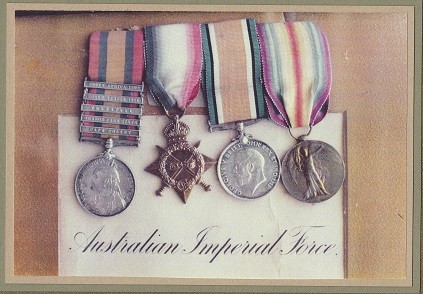
Medals of George Frederick Saban
After discharge, George travelled to Canada to join his brother Basil, who was living in Elgin, Manitoba. He tried his hand at wheat farming, but because prices were not very favourable, part of the crop was turned into whiskey. After some time in Canada, George was quite experienced at dodging Mounties through snow, and bootlegging into the United States.
In 1912, when his luck began to look decidedly less certain, George sailed back to the United Kingdom. Two weeks of rain inspired him to head down to the docks and board the first ship out of the country. This vessel took him to Freemantle, from where he travelled up to Perth. In Western Australia, George resumed wheat farming, and on a property near White Wells north east of Perth, he helped to clear mallee scrub with draft horses, logs and chains in order to start a wheat crop. Tom Saban’s recollection also placed George at ‘Gatham’, a small village with wheat stacks and a railway siding south of Geraldton.

George Frederick Saban on his favourite mare 'Kitty'
After leaving Western Australia, George travelled to South Australia and worked on the Transcontinental Railway Line. When the First World War broke out he was 34 years old, but he enlisted in Liverpool, New South Wales on 6th March 1915, and joined the 12th Light Horse Regiment. He embarked for Egypt then onto Gallipoli, and transferred to the 6th Light Horse in September 1915. He was promoted to Corporal, then transferred back to the 12th Light Horse in Egypt in February 1916.
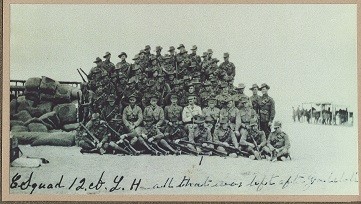
12th Light Horse E Squadron - all that was left after Gallipoli
As the 12th Light Horse proceeded through the Sinai Campaign and into Palestine, George found himself promoted again in June 1917 to Squadron Sergeant Major (Warrant Officer 2). He participated in the famous Charge of Beersheba, or ‘Beer and Sheilas’ as the troops nicknamed it, during which he was wounded. Two Turks tried to drag him off ‘Kitty’, his favourite mare, and she reared and killed them both with her front hooves. Unfortunately she then caught a bullet in her head, which would surely have killed George too. Farewell faithful Kitty. She and George had survived seven battles and dozens of smaller engagements together.
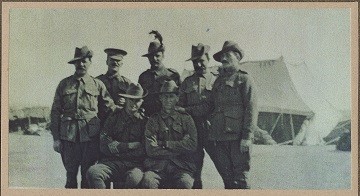

A few of the boys, taken two days before Beersheba, 31 October 1917
In October 1917 George was transferred to the 4th Light Horse Training Regiment until January 1918, when he returned to the 12th Light Horse. The Mounted Divisions chased the retreating Turkish army back through Syria, and George finally embarked for Australia on the Morvada on 20th July 1919.
After the Beersheba campaign George needed new socks, and had received a pair from an Emma Amelia Hunt from Sydney. He and Emma corresponded for the rest of the war, and in 1921 she became his wife. George received a soldier settlement at Guyra in New South Wales, and he and Emma settled down to farm potatoes and raise a family.

Unfortunately, during the Depression they could not generate enough return on the potato crop, so they walked off the property and settled in Inverell. George operated a fruit run in the township from 1937 until his retirement in 1957, and he and Emma raised two sons - George and Thomas, and three daughters - Olive, Cynthia and Ethel. Their eldest son George (Jnr) served in New Guinea and Borneo in the Second World War.

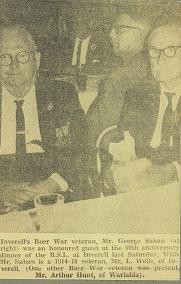
Comments
Your email address will not be published.
We welcome relevant, respectful comments.